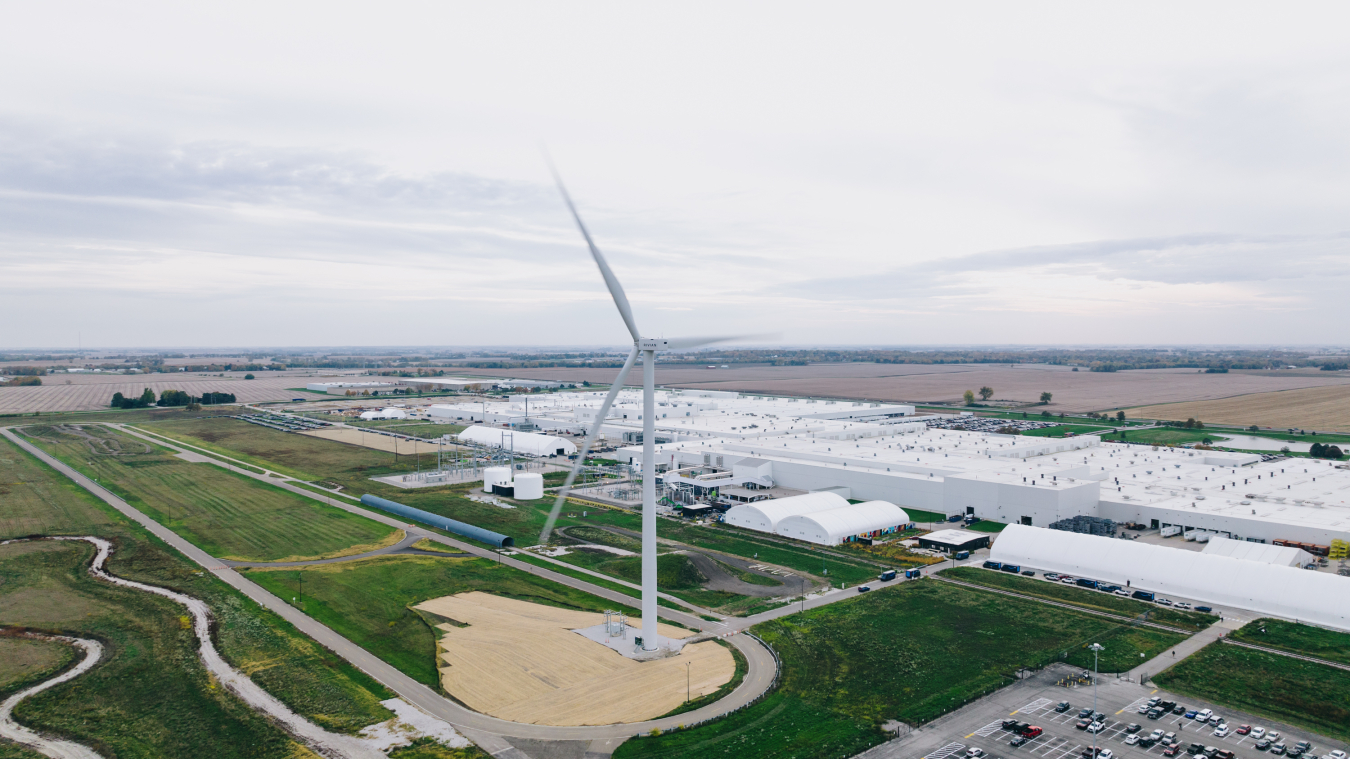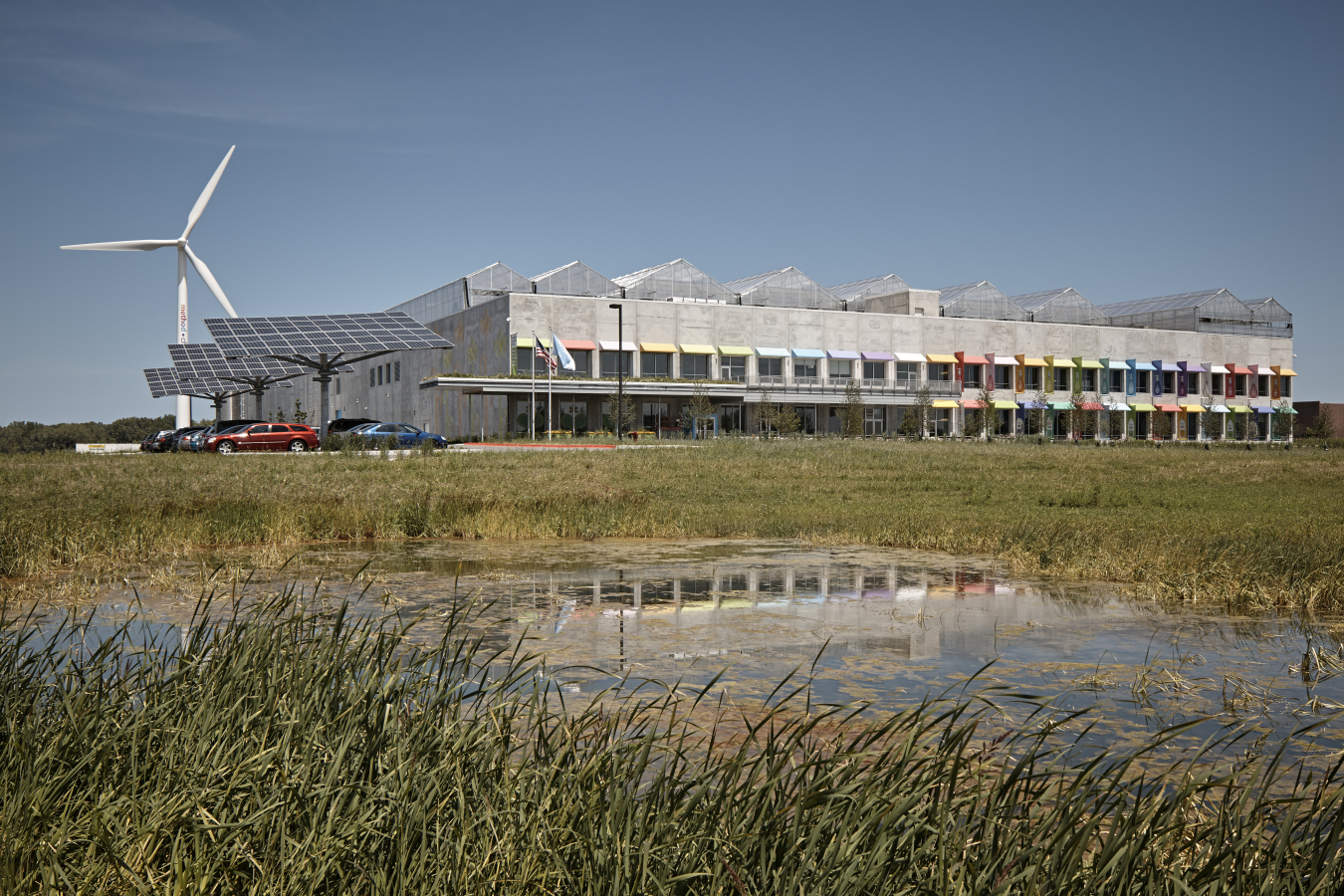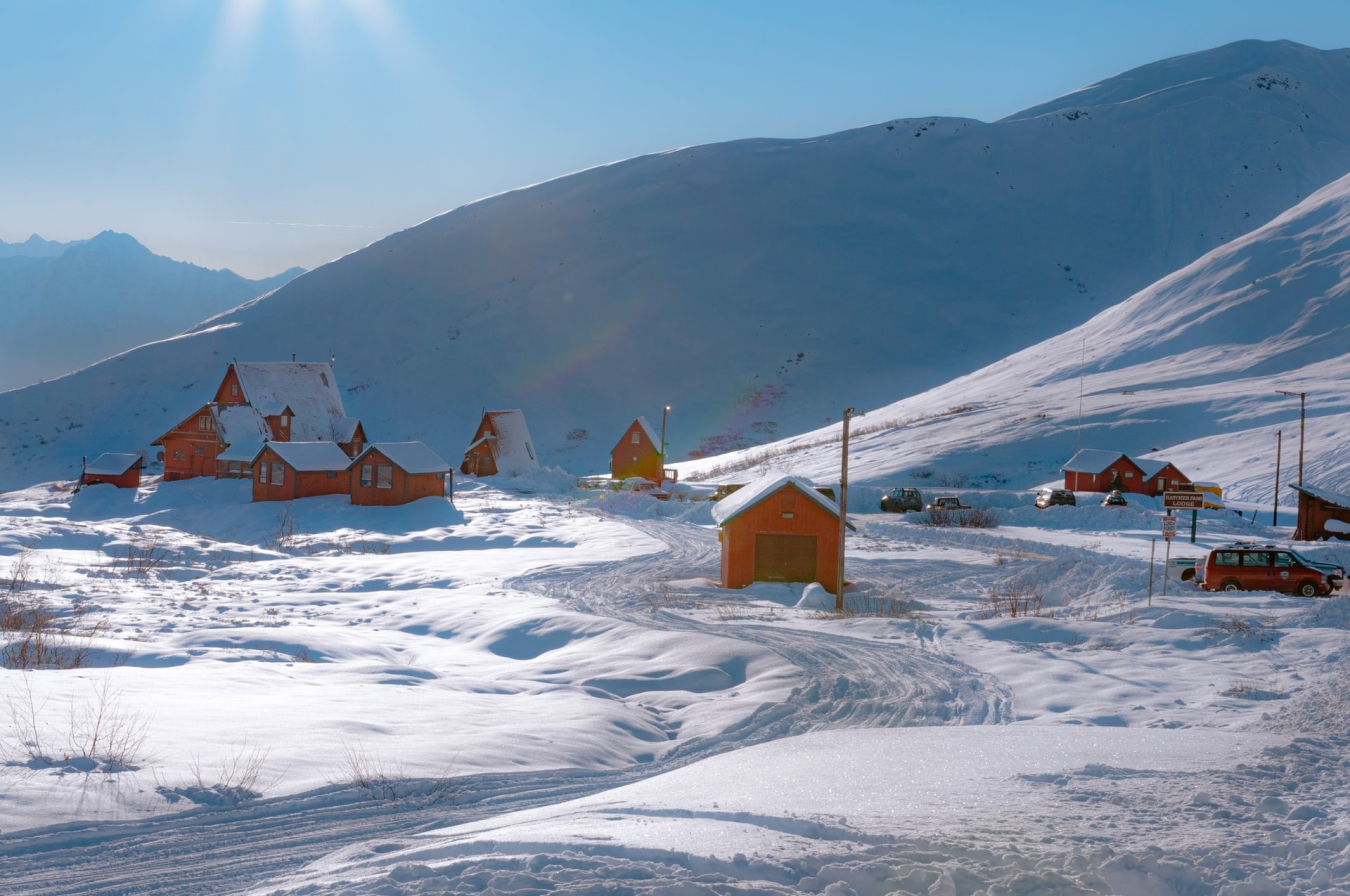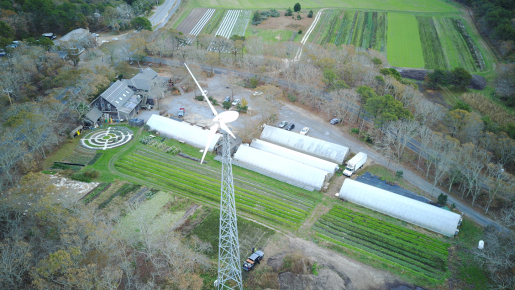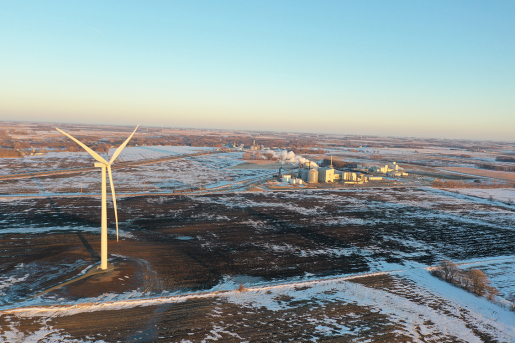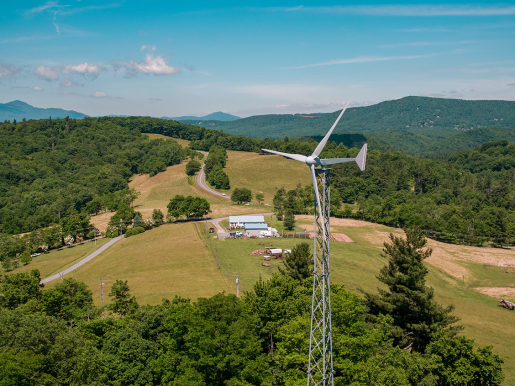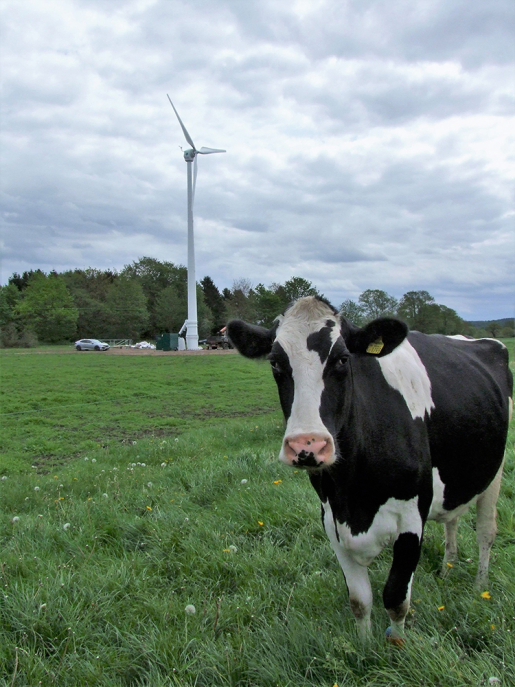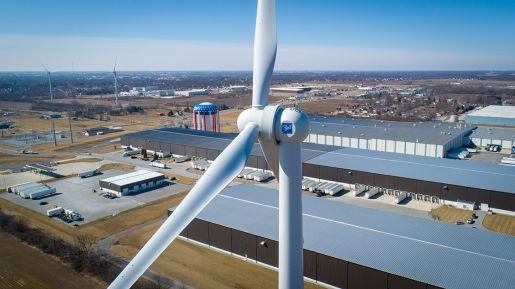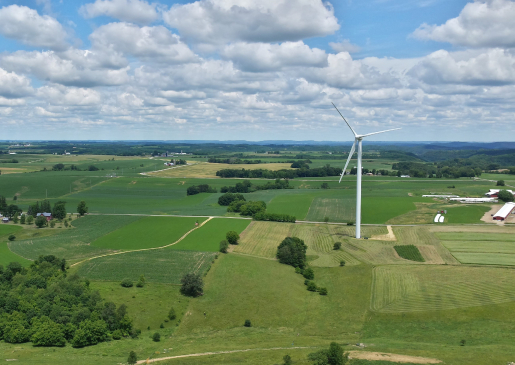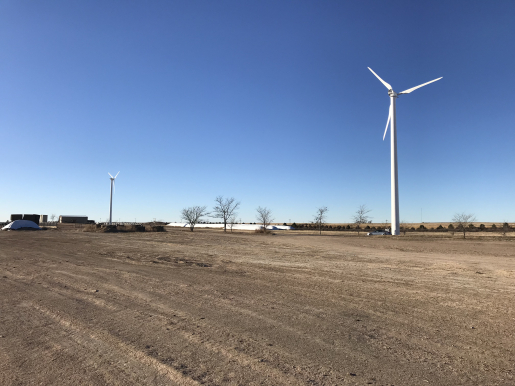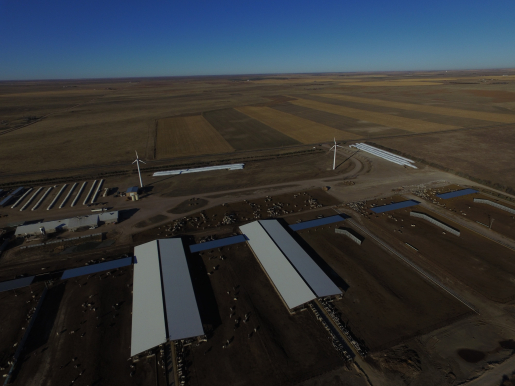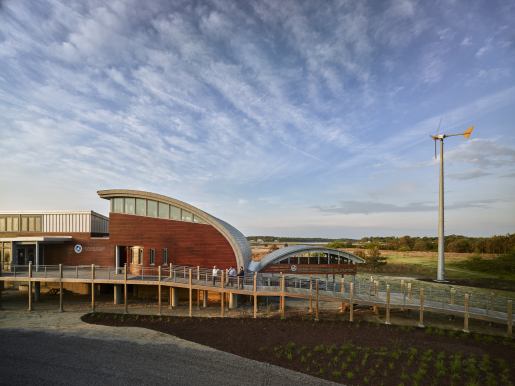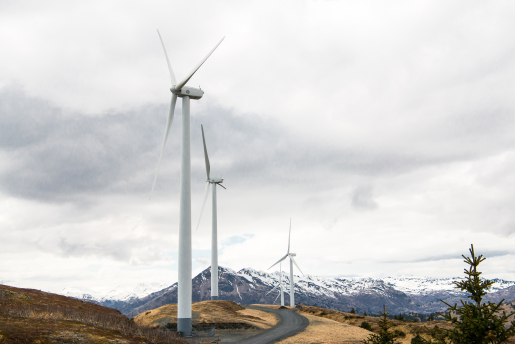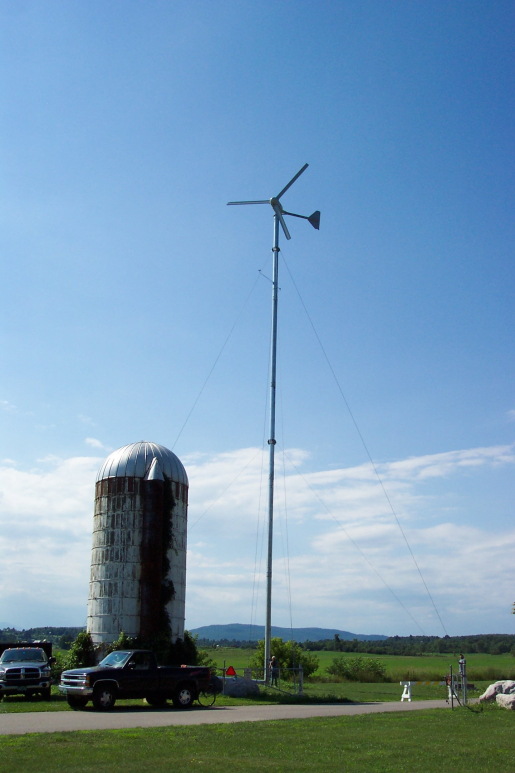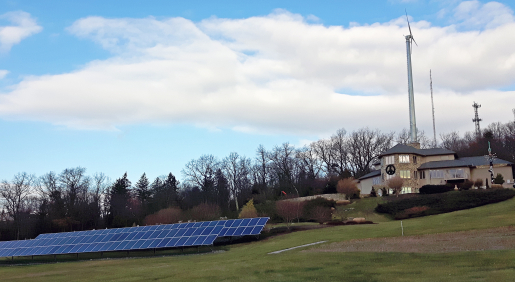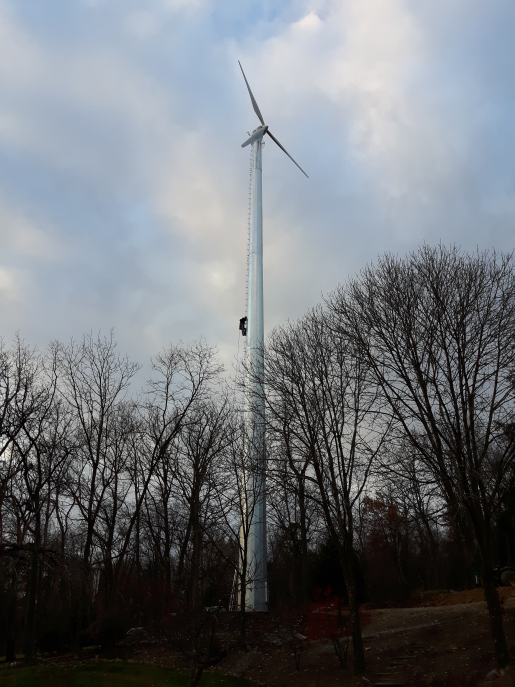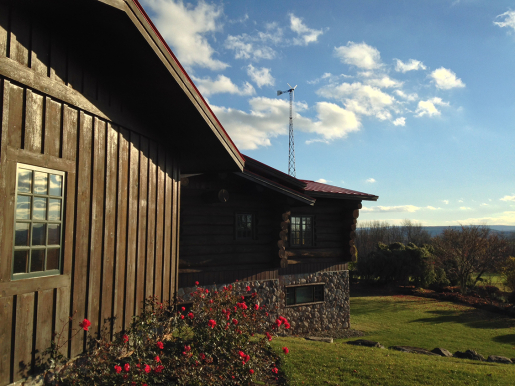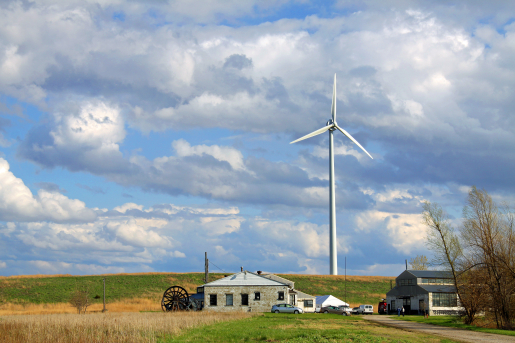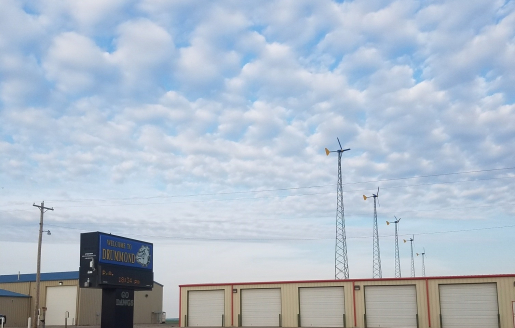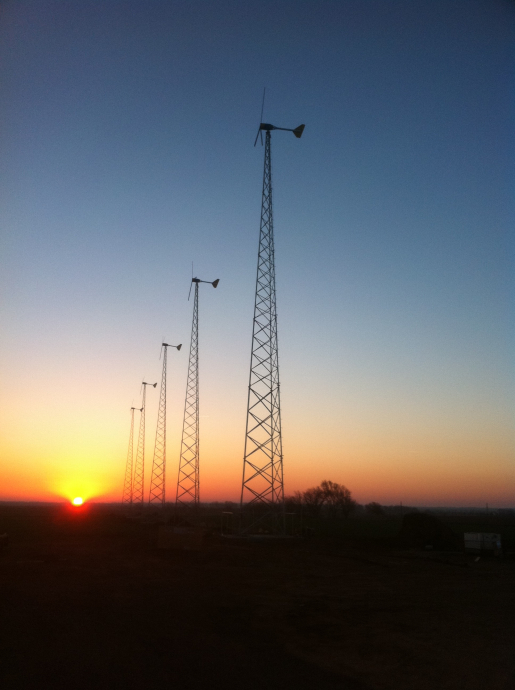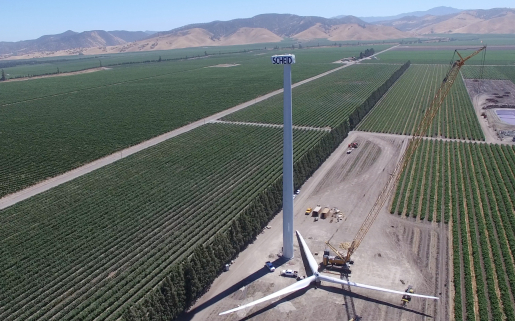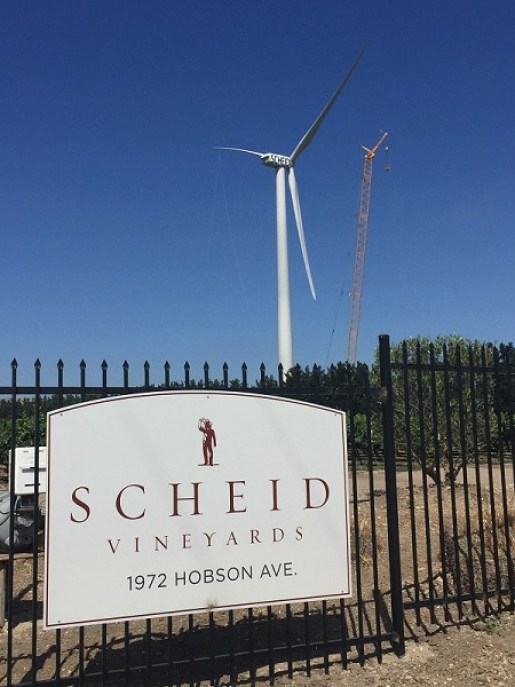Blog
Three Places American Energy Consumers Are Using Local Wind Power
New DOE report on wind energy shows distributed wind energy—wind turbines that provide power for nearby consumers—is expanding across the nation, benefiting a wide range of organizations and communities, from large corporations to remote villages.
Office of Critical Minerals and Energy Innovation
August 16, 2022
 min
minute read time
min
minute read time
A new U.S. Department of Energy (DOE) report on wind energy shows distributed wind energy—wind turbines that provide power for nearby consumers—is expanding across the nation, benefiting a wide range of organizations and communities, from large corporations to remote villages.
The latest edition of DOE’s Distributed Wind Market Report finds that all 50 states, the District of Columbia, Puerto Rico, Guam, and the U.S. Virgin Islands have installed a combined 1,075 megawatts (MW) of distributed wind. While this is a fraction of the enormous potential for distributed wind energy, we wanted to highlight a few places you’ll find it today.
Anheuser-Busch
Maybe you associate beer with a relaxing summer breeze as opposed to wind energy, but now you can associate it with both. California’s Anheuser-Busch plant uses an 80-meter wind turbine named Bud Light and a 91-meter wind turbine named Budweiser to help power its brewery, together providing 4.1 MW of capacity. Both turbines—and a 7-acre solar array—provide 30% of the plant’s electrical needs so it can produce around 33,000 cases of beer per day.
Method Cleaning Supplies
Washing our hands has never been more important, and Chicago-based Method has met demand by producing 250,000 units of biodegradable soap every day. What’s more: The company combined cleanliness and energy by throwing a wind turbine into the mix. About half of Method’s eco-friendly facility is powered by a refurbished 600-kilowatt (kW) wind turbine. Soap has never been cleaner!
Pitka’s Point, a Remote Alaskan Village
A research team from Pacific Northwest National Laboratory and Sandia National Laboratories published a study earlier this year highlighting the economic and climate benefits that wind energy provides to three remote, rural Alaskan villages: St. Mary’s, Pitka’s Point, and Mountain Village. In 2019, Alaska Village Electric Cooperative installed a 900-kW wind turbine in Pitka’s Point, partially funded through a 2016 DOE Office of Indian Energy Grant. This turbine serves all three villages and could save $5.3 million in diesel costs over its lifetime. The study makes a powerful case for the potential benefits distributed wind could offer other rural and underserved populations.
Is Distributed Wind Right for You?
The Distributed Wind Energy Futures Study identifies locations across the United States with high potential for distributed wind energy projects. It can serve as a resource for any company or community interested in learning if distributed wind can help them lower energy costs and transition to renewable energy. The study was funded by DOE’s Wind Energy Technologies Office (WETO).
Check out WETO’s Distributed Wind Photo Gallery for case studies and more examples of distributed wind’s diversity.
Caption
This is an E3120 at a small farm. While Endurance is out of business, folks like Gary Harcourt and Ian Sleger of All Energy Management are busy refurbishing these machines all over the world. Location: Edgartown, Massachusetts
Credit
Photo: Gary Harcourt / Great Rock Windpower
Caption
This Juhl project shows large wind in a distributed application. Location: Glenville, Minnesota
Credit
Photo: Juhl Energy
Caption
Bergey Excel 15 repowered a defunct Proven 15 in Blowing Rock, NC, along the Blue Ridge Parkway.
Credit
Photo: Jordan Nelson / Nelson Aerial Productions
Caption
This is a cow...and an Eocycle 25 kW on a farm. Location: England
Credit
Credit: Eocycle Technologies Inc.
Caption
Goldwind at the Ball plant. Location: Ohio
Credit
Credit: Hank Doster / One Energy Enterprise LLC
Caption
One of two turbines owned by Gundersen Health System and Organic Valley near Cashton, Wisconsin. The electricity from this wind farm is used by homes and businesses, as well as fed into the energy grid. Gundersen and Organic Valley are paid for the energy generated.
Credit
Photo: Roy Rakobitsch, Windsine, Inc.
Caption
This dairy farm in Yuma, Colorado, is an agricultural facility that utilizes two 100-kilowatt Northern Power Systems wind turbines to offset high energy demand.
Credit
Photo: Trevor Atkinson, NREL 51791
Caption
The Heritage Dairy Farm in Yuma, Colorado, is an agricultural facility that features unobstructed wind and utilizes two Northern Power Systems wind turbines.
Credit
Photo: Charles Newcomb
Caption
Installed in 2016, this Northern Power Systems wind turbine, located in St. Francis, Kansas, will offset energy needs for the owner’s agricultural facility.
Credit
Photo: Charles Newcomb
Caption
The Brock Environmental Center in Virginia Beach, Virginia, has two 10-kilowatt turbines installed, integrated with solar panels and geothermal wells. The center produces more electricity than it uses.
Credit
Photo: SmithGroupJJR / © Prakash Patel
Caption
The Kodiak Electric Association installed wind turbines to help meet the renewable power goals of Kodiak Island, Alaska. There are currently six 1.5-megawatt wind turbines and two 11.5-megawatt hydroelectric turbines integrated into the community’s isolated grid system.
Credit
Photo: Dennis Schroeder, NREL
Caption
Installed in 2008, this 900-kilowatt EWT system is located in Wray, Colorado, and offsets energy needs for the town’s school district.
Credit
Photo: Charles Newcomb
Caption
The “Zephyr Wind Turbine” is named after the sports teams at Mahtomedi High School in St. Cloud, Minnesota This turbine not only produces electricity, but also serves as an educational tool for high school engineering, math, and science students.
Credit
Photo: Jeff Ledermann
Caption
This 10-kilowatt distributed wind system at Middlebury College in Middlebury, Vermont, was developed in partnership with the Vermont Department of Public Service. This system produces 8,000 kilowatt-hours of electricity each year.
Credit
Photo: Bergey WindPower
Caption
One of two wind turbines installed at the Triad Recycling and Energy Corporation in Tonawanda, New York. The recycling center is surrounded by open spaces and unobstructed winds, making it an ideal location for a distributed wind system.
Credit
Photo: Padma Kasathurirangan
Caption
Two Northern Power Systems wind turbines were installed at the Triad Recycling and Energy Corporation in Tonawanda, New York, to cost-effectively offset the power required by energy-intensive recycling equipment.
Credit
Photo: Padma Kasathurirangan
Caption
A homeowner in York, Pennsylvania, installed a 30-kilowatt solar array and a 25-kilowatt Eocycle wind turbine in 2018.
Credit
Credit: Eocycle Technologies Inc.
Caption
A wind turbine installer climbs a 140-foot, 25-kilowatt Eocycle wind turbine in York, Pennsylvania, during construction in 2018.
Credit
Credit: Eocycle Technologies Inc.
Caption
This Weaver 5 turbine was installed at a home in New York State.
Credit
Photo: Weaver Wind Energy
Caption
The Gob Nob wind turbine in Farmersville, Illinois is located on the former Freeman United Crown Number 1 Coal Mine.
Caption
The EWT DW54-900kW Gob Nob wind turbine in Farmersville, Illinois produced 2,173,088 kWh in 2017, which was distributed to 380 local coop member’s homes.
Caption
The town of Drummond received an Oklahoma Department of Commerce Energy Efficiency and Conservation grant to install five wind turbines next to the public school. The funding was key to the successful completion of this project.
Credit
Photo: Pieter Huebner
Caption
The Drummond turbines are installed on 120-foot self-supporting towers.
Credit
Photo: Pieter Huebner
Caption
Under a power purchase agreement structure, this GE 1.85-megawatt wind turbine is owned and operated by an affiliate of Foundation Windpower, LLC. The project is hosted by Scheid Fmaily Wines in Salinas Valley, California, an agricultural operation that features access to an unobstructed wind resource.
Credit
Photo: Foundation Windpower, LLC
Caption
The Scheid distributed wind installation is Foundation Windpower's third Salinas Valley project.
Credit
Photo: Foundation Windpower, LLC
Caption
This is an E3120 at a small farm. While Endurance is out of business, folks like Gary Harcourt and Ian Sleger of All Energy Management are busy refurbishing these machines all over the world. Location: Edgartown, Massachusetts
Credit
Photo: Gary Harcourt / Great Rock Windpower
This is an E3120 at a small farm. While Endurance is out of business, folks like Gary Harcourt and Ian Sleger of All Energy Management are busy refurbishing these machines all over the world. Location: Edgartown, Massachusetts
Photo: Gary Harcourt / Great Rock Windpower
Caption
This Juhl project shows large wind in a distributed application. Location: Glenville, Minnesota
Credit
Photo: Juhl Energy
This Juhl project shows large wind in a distributed application. Location: Glenville, Minnesota
Caption
Bergey Excel 15 repowered a defunct Proven 15 in Blowing Rock, NC, along the Blue Ridge Parkway.
Credit
Photo: Jordan Nelson / Nelson Aerial Productions
Bergey Excel 15 repowered a defunct Proven 15 in Blowing Rock, NC, along the Blue Ridge Parkway.
Photo: Jordan Nelson / Nelson Aerial Productions
Caption
This is a cow...and an Eocycle 25 kW on a farm. Location: England
Credit
Credit: Eocycle Technologies Inc.
This is a cow...and an Eocycle 25 kW on a farm. Location: England
Credit: Eocycle Technologies Inc.
Caption
Goldwind at the Ball plant. Location: Ohio
Credit
Credit: Hank Doster / One Energy Enterprise LLC
Goldwind at the Ball plant. Location: Ohio
Credit: Hank Doster / One Energy Enterprise LLC
Caption
One of two turbines owned by Gundersen Health System and Organic Valley near Cashton, Wisconsin. The electricity from this wind farm is used by homes and businesses, as well as fed into the energy grid. Gundersen and Organic Valley are paid for the energy generated.
Credit
Photo: Roy Rakobitsch, Windsine, Inc.
One of two turbines owned by Gundersen Health System and Organic Valley near Cashton, Wisconsin. The electricity from this wind farm is used by homes and businesses, as well as fed into the energy grid. Gundersen and Organic Valley are paid for the energy generated.
Photo: Roy Rakobitsch, Windsine, Inc.
Caption
This dairy farm in Yuma, Colorado, is an agricultural facility that utilizes two 100-kilowatt Northern Power Systems wind turbines to offset high energy demand.
Credit
Photo: Trevor Atkinson, NREL 51791
This dairy farm in Yuma, Colorado, is an agricultural facility that utilizes two 100-kilowatt Northern Power Systems wind turbines to offset high energy demand.
Photo: Trevor Atkinson, NREL 51791
Caption
The Heritage Dairy Farm in Yuma, Colorado, is an agricultural facility that features unobstructed wind and utilizes two Northern Power Systems wind turbines.
Credit
Photo: Charles Newcomb
The Heritage Dairy Farm in Yuma, Colorado, is an agricultural facility that features unobstructed wind and utilizes two Northern Power Systems wind turbines.
Caption
Installed in 2016, this Northern Power Systems wind turbine, located in St. Francis, Kansas, will offset energy needs for the owner’s agricultural facility.
Credit
Photo: Charles Newcomb
Installed in 2016, this Northern Power Systems wind turbine, located in St. Francis, Kansas, will offset energy needs for the owner’s agricultural facility.
Caption
The Brock Environmental Center in Virginia Beach, Virginia, has two 10-kilowatt turbines installed, integrated with solar panels and geothermal wells. The center produces more electricity than it uses.
Credit
Photo: SmithGroupJJR / © Prakash Patel
The Brock Environmental Center in Virginia Beach, Virginia, has two 10-kilowatt turbines installed, integrated with solar panels and geothermal wells. The center produces more electricity than it uses.
Photo: SmithGroupJJR / © Prakash Patel
Caption
The Kodiak Electric Association installed wind turbines to help meet the renewable power goals of Kodiak Island, Alaska. There are currently six 1.5-megawatt wind turbines and two 11.5-megawatt hydroelectric turbines integrated into the community’s isolated grid system.
Credit
Photo: Dennis Schroeder, NREL
The Kodiak Electric Association installed wind turbines to help meet the renewable power goals of Kodiak Island, Alaska. There are currently six 1.5-megawatt wind turbines and two 11.5-megawatt hydroelectric turbines integrated into the community’s isolated grid system.
Photo: Dennis Schroeder, NREL
Caption
Installed in 2008, this 900-kilowatt EWT system is located in Wray, Colorado, and offsets energy needs for the town’s school district.
Credit
Photo: Charles Newcomb
Installed in 2008, this 900-kilowatt EWT system is located in Wray, Colorado, and offsets energy needs for the town’s school district.
Caption
The “Zephyr Wind Turbine” is named after the sports teams at Mahtomedi High School in St. Cloud, Minnesota This turbine not only produces electricity, but also serves as an educational tool for high school engineering, math, and science students.
Credit
Photo: Jeff Ledermann
The “Zephyr Wind Turbine” is named after the sports teams at Mahtomedi High School in St. Cloud, Minnesota This turbine not only produces electricity, but also serves as an educational tool for high school engineering, math, and science students.
Caption
This 10-kilowatt distributed wind system at Middlebury College in Middlebury, Vermont, was developed in partnership with the Vermont Department of Public Service. This system produces 8,000 kilowatt-hours of electricity each year.
Credit
Photo: Bergey WindPower
This 10-kilowatt distributed wind system at Middlebury College in Middlebury, Vermont, was developed in partnership with the Vermont Department of Public Service. This system produces 8,000 kilowatt-hours of electricity each year.
Caption
One of two wind turbines installed at the Triad Recycling and Energy Corporation in Tonawanda, New York. The recycling center is surrounded by open spaces and unobstructed winds, making it an ideal location for a distributed wind system.
Credit
Photo: Padma Kasathurirangan
One of two wind turbines installed at the Triad Recycling and Energy Corporation in Tonawanda, New York. The recycling center is surrounded by open spaces and unobstructed winds, making it an ideal location for a distributed wind system.
Photo: Padma Kasathurirangan
Caption
Two Northern Power Systems wind turbines were installed at the Triad Recycling and Energy Corporation in Tonawanda, New York, to cost-effectively offset the power required by energy-intensive recycling equipment.
Credit
Photo: Padma Kasathurirangan
Two Northern Power Systems wind turbines were installed at the Triad Recycling and Energy Corporation in Tonawanda, New York, to cost-effectively offset the power required by energy-intensive recycling equipment.
Photo: Padma Kasathurirangan
Caption
A homeowner in York, Pennsylvania, installed a 30-kilowatt solar array and a 25-kilowatt Eocycle wind turbine in 2018.
Credit
Credit: Eocycle Technologies Inc.
A homeowner in York, Pennsylvania, installed a 30-kilowatt solar array and a 25-kilowatt Eocycle wind turbine in 2018.
Credit: Eocycle Technologies Inc.
Caption
A wind turbine installer climbs a 140-foot, 25-kilowatt Eocycle wind turbine in York, Pennsylvania, during construction in 2018.
Credit
Credit: Eocycle Technologies Inc.
A wind turbine installer climbs a 140-foot, 25-kilowatt Eocycle wind turbine in York, Pennsylvania, during construction in 2018.
Credit: Eocycle Technologies Inc.
Caption
This Weaver 5 turbine was installed at a home in New York State.
Credit
Photo: Weaver Wind Energy
This Weaver 5 turbine was installed at a home in New York State.
Photo: Weaver Wind Energy
Caption
The Gob Nob wind turbine in Farmersville, Illinois is located on the former Freeman United Crown Number 1 Coal Mine.
The Gob Nob wind turbine in Farmersville, Illinois is located on the former Freeman United Crown Number 1 Coal Mine.
Caption
The EWT DW54-900kW Gob Nob wind turbine in Farmersville, Illinois produced 2,173,088 kWh in 2017, which was distributed to 380 local coop member’s homes.
The EWT DW54-900kW Gob Nob wind turbine in Farmersville, Illinois produced 2,173,088 kWh in 2017, which was distributed to 380 local coop member’s homes.
Caption
The town of Drummond received an Oklahoma Department of Commerce Energy Efficiency and Conservation grant to install five wind turbines next to the public school. The funding was key to the successful completion of this project.
Credit
Photo: Pieter Huebner
The town of Drummond received an Oklahoma Department of Commerce Energy Efficiency and Conservation grant to install five wind turbines next to the public school. The funding was key to the successful completion of this project.
Caption
The Drummond turbines are installed on 120-foot self-supporting towers.
Credit
Photo: Pieter Huebner
The Drummond turbines are installed on 120-foot self-supporting towers.
Caption
Under a power purchase agreement structure, this GE 1.85-megawatt wind turbine is owned and operated by an affiliate of Foundation Windpower, LLC. The project is hosted by Scheid Fmaily Wines in Salinas Valley, California, an agricultural operation that features access to an unobstructed wind resource.
Credit
Photo: Foundation Windpower, LLC
Under a power purchase agreement structure, this GE 1.85-megawatt wind turbine is owned and operated by an affiliate of Foundation Windpower, LLC. The project is hosted by Scheid Fmaily Wines in Salinas Valley, California, an agricultural operation that features access to an unobstructed wind resource.
Photo: Foundation Windpower, LLC
Caption
The Scheid distributed wind installation is Foundation Windpower's third Salinas Valley project.
Credit
Photo: Foundation Windpower, LLC
The Scheid distributed wind installation is Foundation Windpower's third Salinas Valley project.
Photo: Foundation Windpower, LLC
